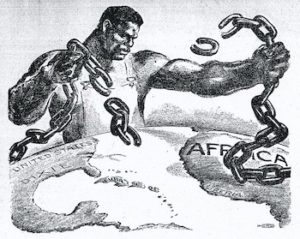
*On this date in 1925, the first meeting of the American Negro Labor Congress took place. It was established by the Communist Party as a vehicle for advancing the rights of African Americans, propagandizing communism within the Black community, and recruiting black members for the party.
The organization opened in Chicago. It attacked the segregationist practices of many unions affiliated with the American Federation of Labor (AFL). It campaigned against lynching, the disfranchisement of black Americans, and Jim Crow laws. The group was renamed the League of Struggles for Negro Rights in 1930. The League supported the "Scottsboro Boys," nine black men sentenced to death in 1931 for crimes they had not committed.
It also campaigned for a separate black nation in the South, one of the CPUSA's principal tenets, against police brutality, the Italian occupation of Ethiopia, and Jim Crow laws. The League of Struggle for Negro Rights also advocated a more general policy of opposition to fascism and support for the Soviet Union. Langston Hughes became its President in 1934. Harry Haywood was its General Secretary. The organization largely disappeared after 1935, when the Communist Party, as part of its Popular Front strategy, joined with other non-communist organizations and individuals to form the National Negro Congress (NNC) 1935 at Howard University.
This was a broadly-based organization to fight for Black liberation. During the Great Depression, the party worked in the United States to unite black and white workers and intellectuals in fighting racial justice. This period represented the Party's peak of prestige in African American communities. NNC opposed war, fascism, and discrimination, especially racial discrimination. During the Great Depression, most Americans faced immense economic problems. Many lost their jobs and, as a result, were forced to live at the margins of society. The crisis highlighted inequities for many African Americans, who were unemployed at higher rates than white. Historically, many black workers were segregated and racially discriminated against in the labor force.
To combat racism within their respective jobs, they had to establish a union. However, many white unions during the Depression excluded African Americans from their protection and benefits. Black workers took the initiative to unite against racism and classism. "John P. Davis and Communist Party leader James Ford decided to bring together meaningful organizations that would be dedicated in the ongoing fight against racial discrimination." Class does not embody one particular race but transcends racial borders to integrate many ethnic groups to face a similar struggle: a class struggle.
Around 1946, the NNC merged with the International Labor Defense (ILD) and National Federation for Constitutional Liberties (NFCL), a civil rights advocacy group. They comprised many people (including many trade unionists, religious organizations, African American civil rights advocates, and professional organizations). The NFCL was founded at a national conference on civil liberties held in Washington, D.C., in June 1940; it lasted until 1946. The purpose of the Federation was to coordinate the activities of the various groups involved within the organization to gain greater democratic freedoms for civil rights advocacy. They also were against lynching, poll tax, and discrimination, the Jim Crow laws and ran campaigns.
In a proposed Anti-Fascist Civil Rights Declaration for 1944, the Federation called for a permanent Fair Employment Practice Committee (FEPC), equality within the US armed forces, legislation against antisemitism and all forms of incitement to racial hatred, a ban on discrimination in employment and housing, the abolition of Jim Crow, and passage of a federal anti-lynching bill. The Federation publicized its campaigns and other activities through numerous pamphlets and Action Letters mailed to thousands of local leaders, unions, churches, and civic and professional groups.
They organized conferences, public meetings, and banquets with outstanding speakers and civil liberties advocates. Its Academic Council led the defense of educators blacklisted by the United States for their political beliefs. The Federation was considered "subversive" and "Communist" by Attorney General Tom C. Clark. On April 3, 1947, at the request of Clark, the group was considered one of eleven "subversive organizations" drawn up by Attorney General Francis Biddle.
The Civil Rights Congress (CRC) was an American civil rights organization, formed in 1946 at a national conference for radicals and disbanded in 1956. It succeeded the International Labor Defense, the National Federation for Constitutional Liberties, and the National Negro Congress, serving primarily as a defense organization. In 1948, it became involved in representing African Americans sentenced to death and other criminal cases to highlight racial injustice in the United States.
After Rosa Lee Ingram and her two teenage sons were sentenced in Georgia, the CRC conducted a national appeals campaign on their behalf. This was a first for African Americans. The CRC coordinated nationally, with 60 chapters at its peak in 1950. These acted on local issues. Most were located on the East and West coasts, with only about ten chapters in the states of the former Confederacy, five of them in Texas.
